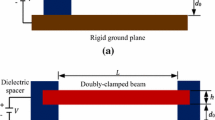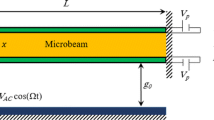Abstract
In this study, nonlinear static and dynamic responses of a microcantilever with a T-shaped tip mass excited by electrostatic actuations are investigated. The electrostatic force is generated by applying an electric voltage between the horizontal part of T-shaped tip mass and an opposite electrode plate. The cantilever microbeam is modeled as an Euler–Bernoulli beam. The T-shaped tip mass is assumed to be a rigid body and the nonlinear effect of electrostatic force is considered. An equation of motion and its associated boundary conditions are derived by the aid of combining the Hamilton principle and Newton’s method. An exact solution is obtained for static deflection and mode shape of vibration around the static position. The differential equation of nonlinear vibration around the static position is discretized using the Galerkin method. The system mode shapes are used as its related comparison functions. The discretized equations are solved by the perturbation theory in the neighborhood of primary and subharmonic resonances. In addition, effects of mass inertia, mass moment of inertia as well as rotation of the T-shaped mass, which were ignored in previous works, are considered in the analysis. It is shown that by increasing the length of the horizontal part of the T-shaped mass, the amount of static deflection increases, natural frequency decreases and nonlinear shift of the resonance frequency increases. It is concluded that attaching an electrode plate with a T-shaped configuration to the end of the cantilever microbeam results in a configuration with larger pull-in voltage and smaller nonlinear shift of the resonance frequency compared to the configuration in which the electrode plate is directly attached to it.



















Similar content being viewed by others
References
Gaura, E., Newman, R.: Smart MEMS and Sensor Systems. Imperial College Press, London (2006)
Younis, M.I.: MEMS Linear and Nonlinear Statics and Dynamics. Springer, New York (2011)
Xu, L., Jia, X.: Electromechanical coupled nonlinear dynamics for microbeams. Arch. Appl. Mech. 77, 485–502 (2007)
Chaterjee, S., Pohit, G.: A large deflection model for the pull-in analysis of electrostatically actuated microcantilever beams. J. Sound Vib. 322, 969–986 (2009)
Rasekh, M., Khadem, S.E.: Pull-in analysis of an electrostatically actuated nano-cantilever beam with nonlinearity in curvature and inertia. Int. J. Mech. Sci. 53, 108–115 (2011)
Zhang, Y., Zhao, Y.: Numerical and analytical study on the pull-in instability of micro-structure under electrostatic loading. Sens. Actuators A 127, 366–380 (2006)
Fang, Y., Li, P.: A new approach and model for accurate determination of the dynamic pull-in parameters of microbeam actuated by a step voltage. Micromech. Microeng. 23, 045010–045021 (2013)
Huang, Y.T., Chen, H.L., Hsu, W.: An analytical model for calculating the pull-in voltage of micro cantilever beams subjected to tilted and curled effects. Microelectron. Eng. 125, 73–77 (2014)
Rahaeifard, M., Ahmadian, M.T.: On pull-in instabilities of microcantilevers. Int. J. Eng. Sci. 87, 23–31 (2015)
Yin, L., Qian, Q., Wang, L.: Size effect on the static behavior of electrostatically actuated microbeams. Acta Mech. Sin. 27, 445–451 (2011)
Kong, S.: Size effect on pull-in behavior of electro-statically actuated micro-beams based on a modified couple stress theory. Appl. Math. Model. 37, 7481–7488 (2013)
Moeenfard, H., Ahmadian, M.T.: Analytical modeling of static behavior of electrostatically actuated nano/micromirrors considering van der Waals forces. Acta Mech. Sin. 28, 729–736 (2012)
Xiao, L.J., Jie, Y., Kitipornchai, S.: Pull-in instability of geometrically nonlinear micro-switches under electrostatic and Casimir forces. Acta. Mech. 218, 161–174 (2011)
Boudjiet, M.T., Bertrand, J., Mathieu, F., et al.: Geometry optimization of uncoated silicon micro-cantilever-based gas density sensors. Sens. Actuators B 208, 600–607 (2015)
Abdalla, M.M., Reddy, C.K., Waleed, F.F., et al.: Optimal design of an electrostatically actuated microbeam for maximum pull-in voltage. Comput. Struct. 83, 1320–1329 (2005)
Khushalani, D.G., Dubey, V.R., Bheley, P.P., et al.: Design optimization and fabrication of micro cantilever for switching application. Sens. Actuators A 225, 1–7 (2015)
Younis, M.I., Nayfeh, A.H.: Study of the nonlinear response of a resonant microbeam to an electric actuation. Nonlinear Dyn. 31, 91–117 (2003)
Abdel-Rahman, E.M., Nayfeh, A.H.: Secondary resonances of electrically actuated resonant microsensors. J. Micromech. Microeng. 13, 491–501 (2003)
Nayfeh, A.H., Younis, M.I.: Dynamics of MEMS resonators under superharmonic and subharmonic excitations. J. Micromech. Microeng. 15, 1840–1847 (2005)
Najar, F., Nayfeh, A.H., Abdel-Rahman, E.M., et al.: Nonlinear analysis of MEMS electrostatic microactuators: primary and secondary resonances of the first mode. J. Vib. Control 16, 1321–1349 (2010)
Najar, F., Nayfeh, A.H., Abdel-Rahman, E.M., et al.: Dynamics and global stability of beam-based electrostatic microactuators. J. Vib. Control 16, 721–748 (2010)
Fu, Y.M., Zhang, J.: Nonlinear static and dynamic responses of an electrically actuated viscoelastic microbeam. Acta Mech. Sin. 25, 211–218 (2009)
Zhang, Y., Liu, Y., Murphy, Kevin D.: Nonlinear dynamic response of beam and its application in nanomechanical resonator. Acta Mech. Sin. 28, 190–200 (2012)
Younesian, D., Sadri, M., Esmailzadeh, E.: Primary and secondary resonance analyses of clamped–clamped micro-beams. Nonlinear Dyn. 76, 1867–1884 (2014)
Ghayesh, M.H., Farokhi, H., Amabili, M.: Nonlinear behaviour of electrically actuated MEMS resonators. Int. J. Eng. Sci. 71, 137–155 (2013)
Hajnayeb, A., Khadem, S.E.: Nonlinear vibration and stability analysis of a double-walled carbon nanotube under electrostatic actuation. J. Sound Vib. 331, 2443–2456 (2012)
Zamanian, M., Hosseini, S.: Secondary resonances of a microresonator under AC–DC electrostatic and DC piezoelectric actuations. Struct. Eng. Mech. 42, 677–699 (2012)
Raeisifard, H., Zamanian, M.: Nikkhah Bahrami, M., et al.: On the nonlinear primary resonances of a piezoelectric laminated micro system under electrostatic control voltage. J. Sound Vib. 333, 5494–5510 (2014)
Zamanian, M., Khadem, S.E., Mahmoodi, S.N.: Analysis of non-linear vibrations of a microresonator under piezoelectric and electrostatic actuations. Proc. Inst. Mech. 223, 329–344 (2009)
Wang, H., Meng, Q.: Analytical modeling and experimental verification of vibration-based piezoelectric bimorph beam with a tip-mass for power harvesting. Mech. Syst. Signal Process. 36, 193–209 (2013)
Aboelkassem, Y., Nayfeh, A.H., Ghommem, M.: Bio-mass sensor using an electrostatically actuated microcantilever in a vacuum microchannel. Microsyst. Technol. 16, 1749–1755 (2010)
Khater, M.E., Al-Ghamdi, M., Park, S., et al.: Binary MEMS gas sensors. J. Micromech. Microeng. 24, 065007 (2014)
Shaat, M., Abdelkefi, A.: Modeling of mechanical resonators used for nanocrystalline materials characterization and disease diagnosis of HIVs. Microsyst. Technol. 22, 305–318 (2015)
Mokhtari-Nezhad, F., Saidi, A.R., Ziaei-Rad, S.: Influence of the tip mass and position on the AFM cantilever dynamics. Coupling between bending, torsion and flexural modes. Ultramicroscopy 109, 1193–1202 (2009)
Farrokh Payam, A., Fathipour, M.: Study of the tip mass and interaction force effects on the frequency response and mode shapes of the AFM cantilever. Int. J Adv. Manuf. 65, 957–966 (2013)
Mehdipour, I., Erfani-Moghadam, A., Mehdipour, C.: Application of an electrostatically actuated cantilevered carbon nanotube with an attached mass as a bio-mass sensor. Appl. Phys. 13, 1463–1469 (2013)
Wu, D.H., Chien, W.T., Chen, C.S.: Resonant frequency analysis of fixed-free single-walled carbon nanotube-based mass sensor. Sens. Actuators A 126, 117–121 (2006)
Rasekh, M., Khadem, S.E.: Design and performance analysis of a nano-gyroscope based on electrostatic actuation and capacitive sensing. J. Sound Vib. 332, 6155–6168 (2013)
Mojahedi, M., Ahmadian, M.T., Firoozbakhsh, K.: The influence of the intermolecular surface forces on the static deflection and pull-in instability of the micro/nano cantilever gyroscopes. Compos. Part B 56, 336–343 (2014)
Alsaleem, F.M., Younis, M.I., Ouakad, H.M.: On the nonlinear resonances and dynamic pull-in of electrostatically actuated resonators. J. Micromech. Microeng. 19, 045013 (2009)
Nayfeh, A.H., Ouakad, H.M., Najar, F., et al.: Nonlinear dynamics of a resonant gas sensor. Nonlinear Dyn. 59, 607–618 (2010)
Ouakad, H.M.: The response of a micro-electro-mechanical system (MEMS) cantilever-paddle gas sensor to mechanical shock loads. J. Vib. Control 21, 2739–2754 (2015)
Zamanian, M., Karimiyan, A.: Analysis of the mechanical behavior of a doubled microbeam configuration under electrostatic actuation. Int. J. Mech. Sci. 93, 82–92 (2015)
Zamanian, M., Karimiyan, A., Hosseini, S.A.A., et al.: Nonlinear vibration analysis of a-shaped mass attached to a clamped-clamped microbeam under electrostatic actuation. Proc. Inst. Mech. Eng. C (2016) (in press). doi:10.1177/0954406215627832
Tadayon, M.A., Rajaei, M., Sayyaadi, H., et al.: Nonlinear dynamics of microresonators. J. Phys. Conf. Ser. 34, 961–966 (2006)
Sayyaadi, H., Tadayon, M.A., Eftekharian, A.A.: Micro resonator nonlinear dynamics considering intrinsic properties. J. Sci. Iran. Trans. B Mech. Eng. 16, 121–129 (2009)
Younis, M.I., Alsaleem, F.: Exploration of new concepts for mass detection in electrostatically-actuated structures based on nonlinear phenomena. J. Comput. Nonlinear Dyn. 4, 021010 (2009)
Zamanian, M., Khadem, S.E.: Analysis of thermoelastic damping in microresonators by considering the stretching effect. Int. J. Mech. Sci. 52, 1366–1375 (2010)
Nayfeh, A.H., Younis, M.I.: Modeling and simulations of thermoelastic damping in microplates. J. Micromech. Microeng. 14, 1711–1717 (2004)
Abdel-Rahman, E.M., Younis, M.I., Nayfeh, A.H.: Characterization of the mechanical behavior of an electrically actuated microbeam. J. Micromech. Microeng. 12, 759–766 (2002)
Nayfeh, A.H., Younis, M.I.: A new approach to the modeling and simulation of flexible microstructures under the effect of squeeze-film damping. J. Micromech. Microeng. 14, 170–181 (2004)
Hagedorn, P., DasGupta, A.: Vibrations and Waves in Continuous Mechanical Systems. Wiley, Chichester (2007)
Author information
Authors and Affiliations
Corresponding author
Appendices
Appendix 1
Here the equation of motion and associated boundary conditions for a cantilever beam, shown in the figure below, is derived using the Hamilton principle. It is assumed that the length of the microbeam is \(l+\varepsilon _0 \), and a concentrated force and moment, \(F_\mathrm{s} ,M\) at distance l from the clamped side are applied to it. According to the Hamilton principle [52]:
where T, V, \(W_\mathrm{v}\), and \(W_\mathrm{f} \) are the kinetic energy, potential strain energy, external work due to equivalent viscous damping and external work due to concentrated force and moment, respectively. The variation of these terms are as below (Fig. 20)
Now, if one substitutes Eqs. (56), (57), (59), and (60) into Eq. (54), the equation of motion for microbeam and associated boundary conditions will be:
It is clear that when \(\varepsilon _0 \rightarrow 0\) i.e., one assumes that the external force and moment are at the free boundary, then Eq. (61) results to Eq. (1). It can be considered that if one sets \(\varepsilon _0 =0\), and then substitutes Eq. (58) instead of Eq. (59) into Eq. (54) then the equation of motion for microbeam will be:
Appendix 2
Rights and permissions
About this article
Cite this article
Firouzi, B., Zamanian, M. & Hosseini, S.A.A. Static and dynamic responses of a microcantilever with a T-shaped tip mass to an electrostatic actuation. Acta Mech. Sin. 32, 1104–1122 (2016). https://doi.org/10.1007/s10409-016-0596-9
Received:
Revised:
Accepted:
Published:
Issue Date:
DOI: https://doi.org/10.1007/s10409-016-0596-9





